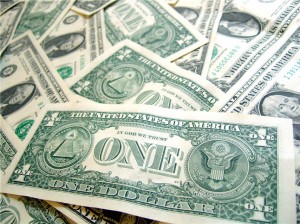13 Nov HOW HEALTHY IS THE DOLLAR?
The strong dollar policy is long gone, but the greenback isn’t in peril just yet.
A favorite doomsday scenario. Have you heard about the forthcoming collapse of the dollar? Well, if you turn on your computer, your radio and even your TV, you just may. With the Federal Reserve poised to increase the money supply, the commentary on this topic is heating up again.
The scenario has variations, but the basic outline goes like this: An unexpected political or economic event leaves the dollar so weak that all confidence in it is gone. Foreign nations sell Treasuries in a panic and the Fed becomes the buyer of last resort. Traders and individual investors dump dollars for whatever they can get. Interest rates leap. Next stop: hyperinflation. America’s economy suddenly resembles that of Zimbabwe in 2007 or Germany in 1922.
So is there any validity to this scenario? Could the dollar collapse?
Let’s just say that the odds are very long. While the Federal Reserve will likely ramp up quantitative easing in the near future, it is highly unlikely that the dollar will suddenly become too cheap.
Why it is unlikely to happen. Foreign countries don’t want the dollar to collapse. Fundamentally, that is because some of the world’s biggest manufacturing economies rely on a great customer for their exports – the United States of America.
China and Japan currently hold 41% of America’s debt.1 In the worthless dollar scenario, they are the key dominoes that fall. But what incentive do China and Japan have to sell dollars? Their economies are tied to U.S. consumer spending. Selling dollars would not benefit them – it would drive up the prices of their exports to America, it would wreck the economy of their best customer, and it would harm their own economies in turn.
The dollar is also the world’s reserve currency; it has been so since the U.S. abandoned the gold standard during the Nixon administration. While the central banks of China and Russia have argued that it should be supplanted or replaced, no challenger has knocked it off its pedestal. In spring 2010, the International Monetary Fund concluded that the dollar still accounted for 61.5% of global foreign exchange reserves, with the euro coming in a very distant second at 27.2%.2
In a way, the dollar has “collapsed” – and America is still standing. The dollar is much weaker today than it was in the 1990s, or even in the early 2000s. Its value has gradually declined and may decline further despite recent surges. In mid-October, the U.S. Dollar Index had slipped about 7% since August, and was approaching an all-time low set back in April 2008.3
America’s debt was less than $3 trillion in 1990; it has doubled since, and the federal Office of Management and Budget thinks it will hit $15 trillion by 2015.1 The federal government would certainly rather pay those debts back using a declining dollar.
Of course, analysts also talked about the pound collapsing and the euro collapsing earlier this year. All this talk – and expectations about what the Fed will do – sent many investors toward the precious metals market, where gold and silver futures hit new highs.
A little word about diversification. When you hear commentators talking about the oncoming collapse of the dollar, take it with a grain of salt. This much is true so far: a dollar decline has occurred, and the dollar could weaken further. So it might be worthwhile to consider diversifying your portfolio as a cautionary move.
Kevin M. Nast is a Financial Advisor and the President of NastGroup Financial in Northville, MI 48167. He may be reached at nastgroupfinancial.com or 248.347.1888. Kevin also services clients in South Lyon, Westland, Northville, Plymouth, Belleville and the surrounding metro Detroit area as well as 13 additional states across the US.
This material was prepared by Peter Montoya Inc., and does not necessarily represent the views of the presenting Representative or the Representative’s Broker/Dealer. This information should not be construed as investment advice. Neither the named Representative nor Broker/Dealer gives tax or legal advice. All information is believed to be from reliable sources; however, we make no representation as to its completeness or accuracy. The publisher is not engaged in rendering legal, accounting or other professional services. If other expert assistance is needed, the reader is advised to engage the services of a competent professional. Please consult your Financial Advisor for further information.. www.petermontoya.com, www.montoyaregistry.com, www.marketinglibrary.net
LD38642-10/10
Citations
1 – azcentral.com [9/19/10]
2 – businessweek.com [6/30/10]
3 – bloomberg.com [10/19/10]





Sorry, the comment form is closed at this time.